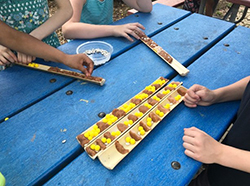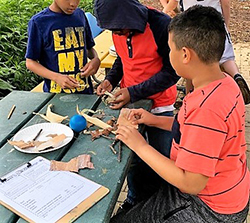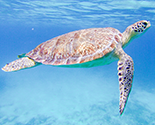Thank you for your interest in WILD at Schools. Unfortunately, on-site components of this program are no longer offered. Electronic lesson plans and downloadable resources are included for educators below.
For information on
Project Wild or
Growing Up Wild programs, please visit the web link or contact Sarah Witcher at
[email protected]
 What is WILD at Schools?
What is WILD at Schools?
Wild at Schools were free, in-school programs tailored to meet curriculum requirements. Program were presented by staff or trained volunteers, but at this time, the program now consists of online lesson plans and resources. Lessons target elementary students (grades K-5) but will be expanded for middle and high schools. Adapted from
Project WILD and
Flying WILD activities, each program aims to increase student’s understanding and awareness of wildlife through hands-on activities. The programs were created specifically to meet
Next Generation Science Standards (NGSS) by covering core content and encouraging critical thinking.
Why WILD at Schools?
WILD at Schools programs have been developed using the latest knowledge and data from Wildlife and Heritage Service biologists and educators. The programs also have been evaluated and improved by Maryland teachers. Additional reasons to use WILD at Schools include:
- Free, hands-on programs for K-5 students
- Aligned with Next Generation Science Standards
- Approved as Maryland Green School Instruction Element
- Optional pre and post activities and assessment sheets included
- Optional outdoor components included
- Can be adapted for summer camps, scout groups, and other K-5 programs
Current Program Options:
Each program has a suggested minimum and maximum class size. The time required is dependent on whether the optional outdoor exploration component is included.
Eat Like a Bear (Grades K-2, 15-40 students)
Mimic how black bears forage for food and discover what bears in Maryland eat, how they are adapted to survive winter and their habitat requirements. Grades 1-2 will also consider how to avoid bear/human conflicts. This activity is based, in part, off of Lunch for a Bear in the Growing Up WILD curriculum supplement. For information on
Growing Up Wild, please contact Sarah Witcher at
[email protected] (45-60 minutes).
 Bee at Home (Grades K, 1 & 3, 15-30 students)
Bee at Home (Grades K, 1 & 3, 15-30 students)
Discover how bees find food and survive and model bee nest building to learn about their lifecycle. Using knowledge of habitat needs, students will investigate if their schoolyard would provide a good home for a bee. Grade 3 will also compare social (group-forming) and solitary bees. (45-60 minutes).
Busy Bees (Grades 2-3, 15-35 students)
Examine the interdependent relationship between Maryland’s native bees and flowers. Actively simulate pollination and when possible, observe real flowers within the schoolyard. Grade 3 will also compare social (group-forming) and solitary bees. Part of this activity is from the Busy Bees, Busy Blooms lesson in the Project WILD curriculum supplement. For information on
Project Wild, please visit the web link or contact the state coordinator: Sarah Witcher at
[email protected]. (50-60 minutes).
Build the Best Nest (Grades 1-5, 15-40 students)
Learn why, where, when and how birds build nests and participate in a STEM challenge where student teams build the best nest they can. (60 minutes).
 Turtle Troubles (Grades 3-5, 15-35 students)
Turtle Troubles (Grades 3-5, 15-35 students)
Examine the largest and smallest turtles found in Maryland and the threats they face. Compare the life cycle of a land and a sea turtle, then explore different scenarios turtles face to survive through hands on activities before students suggest actions to take to help turtles. (60 minutes).
How to bring WILD to your school?
Thank you for your interest in WILD at Schools. Unfortunately, this program will no longer will be offered after February 2019. We will include electronic lesson plans and downloadable resources on this page in the future.
For information on
Project Wild or
Growing Up Wild programs, please visit the web link or contact Sarah Witcher at
[email protected].